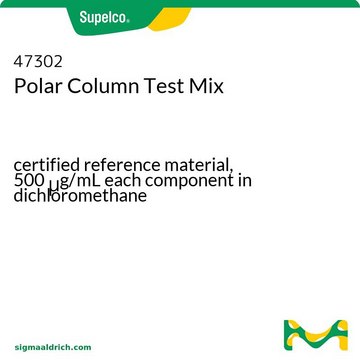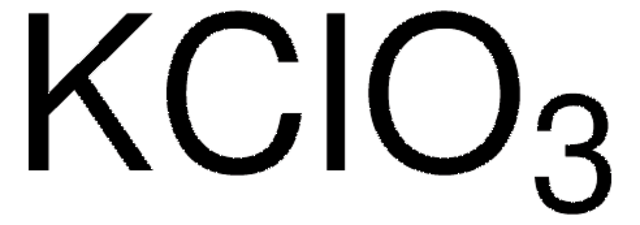Alle Fotos(2)
Wichtige Dokumente
244147
Natriumchlorat
ReagentPlus®, ≥99%
Anmeldenzur Ansicht organisationsspezifischer und vertraglich vereinbarter Preise
Alle Fotos(2)
About This Item
Lineare Formel:
NaClO3
CAS-Nummer:
Molekulargewicht:
106.44
EG-Nummer:
MDL-Nummer:
UNSPSC-Code:
12352302
PubChem Substanz-ID:
NACRES:
NA.55
Assay:
≥99%
Form:
crystals or chunks
Empfohlene Produkte
Qualitätsniveau
Produktlinie
ReagentPlus®
Assay
≥99%
Form
crystals or chunks
mp (Schmelzpunkt)
248-261 °C (lit.)
SMILES String
[Na+].[O-]Cl(=O)=O
InChI
1S/ClHO3.Na/c2-1(3)4;/h(H,2,3,4);/q;+1/p-1
InChIKey
YZHUMGUJCQRKBT-UHFFFAOYSA-M
Suchen Sie nach ähnlichen Produkten? Aufrufen Leitfaden zum Produktvergleich
Verwandte Kategorien
Allgemeine Beschreibung
Sodium chlorate exhibits piezoelectric effect. On heating, it decomposes to give sodium chloride and sodium perchlorate. It can be synthesized in laboratory by reacting chlorine gas with a hot aqueous solution of sodium hydroxide or sodium carbonate.
Anwendung
Sodium chlorate (NaClO3) has been used in the preparation of aromatic amino acid and σ32 peptide (from Drosophila melanogaster) samples for NMR analysis.
It may be used in the synthesis of chlorine dioxide and sodium perchlorate. It may also be employed as a sulfation inhibitor in the culture medium of HepG2 cells ((human hepatocellular liver carcinoma cells).
It may be used in the synthesis of chlorine dioxide and sodium perchlorate. It may also be employed as a sulfation inhibitor in the culture medium of HepG2 cells ((human hepatocellular liver carcinoma cells).
Biochem./physiol. Wirkung
Sulfatierung-Biosynthese-Inhibitor
Rechtliche Hinweise
ReagentPlus is a registered trademark of Merck KGaA, Darmstadt, Germany
Signalwort
Danger
H-Sätze
Gefahreneinstufungen
Acute Tox. 4 Oral - Aquatic Chronic 2 - Ox. Sol. 1
Lagerklassenschlüssel
5.1A - Strongly oxidizing hazardous materials
WGK
WGK 2
Flammpunkt (°F)
Not applicable
Flammpunkt (°C)
Not applicable
Hier finden Sie alle aktuellen Versionen:
Besitzen Sie dieses Produkt bereits?
In der Dokumentenbibliothek finden Sie die Dokumentation zu den Produkten, die Sie kürzlich erworben haben.
Kunden haben sich ebenfalls angesehen
Jung Ho Lee et al.
The journal of physical chemistry. B, 117(20), 6069-6081 (2013-04-09)
NMR is an extremely powerful, yet insensitive technique. Many available nuclear polarization methods that address sensitivity are not directly applicable to low-concentration biomolecules in liquids and are often too invasive. Photochemically induced dynamic nuclear polarization (photo-CIDNP) is no exception. It
Heidi Barth et al.
The Journal of biological chemistry, 278(42), 41003-41012 (2003-07-18)
The conservation of positively charged residues in the N terminus of the hepatitis C virus (HCV) envelope glycoprotein E2 suggests an interaction of the viral envelope with cell surface glycosaminoglycans. Using recombinant envelope glycoprotein E2 and virus-like particles as ligands
Eric Lee et al.
The Journal of emergency medicine, 44(2), 381-384 (2012-05-15)
Chlorate poisoning as a cause of methemoglobinemia is regarded in current literature to be resistant to treatment by methylene blue due to the oxidizing and denaturing properties of the chlorate anion, and often leads to severe renal and hematological complications
Juergen Burkhardt et al.
The New phytologist, 196(3), 774-787 (2012-09-19)
The recent visualization of stomatal nanoparticle uptake ended a 40-yr-old paradigm. Assuming clean, hydrophobic leaf surfaces, the paradigm considered stomatal liquid water transport to be impossible as a result of water surface tension. However, real leaves are not clean, and
Fei Wang et al.
Chemosphere, 89(8), 1009-1014 (2012-08-18)
Understanding the interaction of perfluorochemicals, persistent pollutants with known human health effects, with mineral compounds in surface water and groundwater environments is essential to determining their fate and transport. Kinetic experiments showed that adsorption equilibrium can be achieved within 48
Unser Team von Wissenschaftlern verfügt über Erfahrung in allen Forschungsbereichen einschließlich Life Science, Materialwissenschaften, chemischer Synthese, Chromatographie, Analytik und vielen mehr..
Setzen Sie sich mit dem technischen Dienst in Verbindung.












